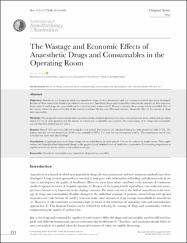| dc.contributor.author | Peker, Kevser | |
| dc.date.accessioned | 2021-01-14T18:10:28Z | |
| dc.date.available | 2021-01-14T18:10:28Z | |
| dc.date.issued | 2020 | |
| dc.identifier.citation | Peker K. The Wastage and Economic Effects of Anaesthetic Drugs and Consumables in the Operating Room. Turk J Anaesthesiol Reanim 2020; 48(4): 321-7. | en_US |
| dc.identifier.issn | 2667-6370 | |
| dc.identifier.uri | https://doi.org/10.5152/TJAR.2019.65632 | |
| dc.identifier.uri | https://hdl.handle.net/20.500.12587/12619 | |
| dc.description | WOS:000557321700009 | en_US |
| dc.description | PubMed: 32864648 | en_US |
| dc.description.abstract | Objective: Anaesthesia is a branch in which new anaesthetic drugs, devices, instruments and new treatment methods have been developed. Because of these innovations, health expenditures have escalated. Anaesthetic drugs and consumables constitute the majority of these expenses. Some waste of used drugs and consumables in the operating room is unavoidable. However, excessive drug wastage can be controlled. One of the ways to reduce the financial burden of this wastage is to know the loss cost. This study aimed to discuss the effect of the wastage of drugs and consumables. Methods: This prospective observational study was conducted in a hospital operating room over a six-week period. At the end of each operation and at the end of each operation day, the amount of wasted and consumables was recorded. The total wastage of the drugs and consumables was calculated by multiplying unit prices. Results: Data of 363 cases were collected during the study period. The total loss cost calculated during the study period was 2543.77 TL. The highest total loss cost was rocuronium (29.95%) and propofol (27.99%). The least loss was neostigmine (0.06%). The consumption rate of consumables was lower than that of drugs. Conclusion: A significant amount of drug wastage was recorded during the study period. This can be reduced by simple means. These applications vary from physician behavioural change to the preparation of standard doses of single-dose preparations. Cost training programmes at regular intervals can also be used as a cost-reduction strategy. | en_US |
| dc.language.iso | eng | en_US |
| dc.publisher | AVES | en_US |
| dc.relation.isversionof | 10.5152/TJAR.2019.65632 | en_US |
| dc.rights | info:eu-repo/semantics/openAccess | en_US |
| dc.subject | Anaesthetic consumable waste | en_US |
| dc.subject | anaesthetic drug wastage | en_US |
| dc.subject | cost effect | en_US |
| dc.title | The Wastage and Economic Effects of Anaesthetic Drugs and Consumables in the Operating Room | en_US |
| dc.type | article | en_US |
| dc.contributor.department | KKÜ | en_US |
| dc.identifier.volume | 48 | en_US |
| dc.identifier.issue | 4 | en_US |
| dc.identifier.startpage | 321 | en_US |
| dc.identifier.endpage | 327 | en_US |
| dc.relation.journal | TURKISH JOURNAL OF ANAESTHESIOLOGY AND REANIMATION | en_US |
| dc.relation.publicationcategory | Makale - Uluslararası Hakemli Dergi - Kurum Öğretim Elemanı | en_US |
















